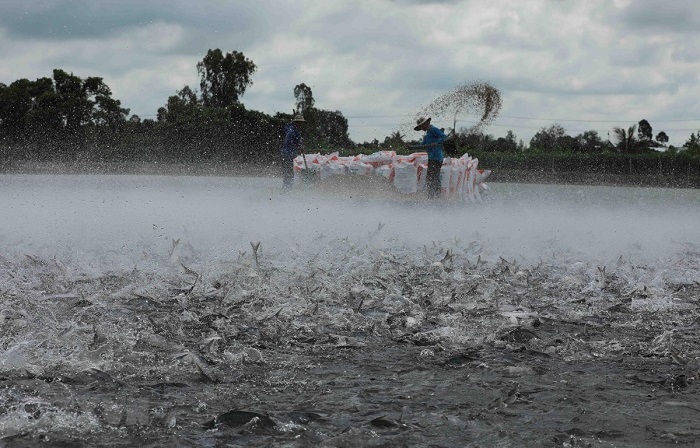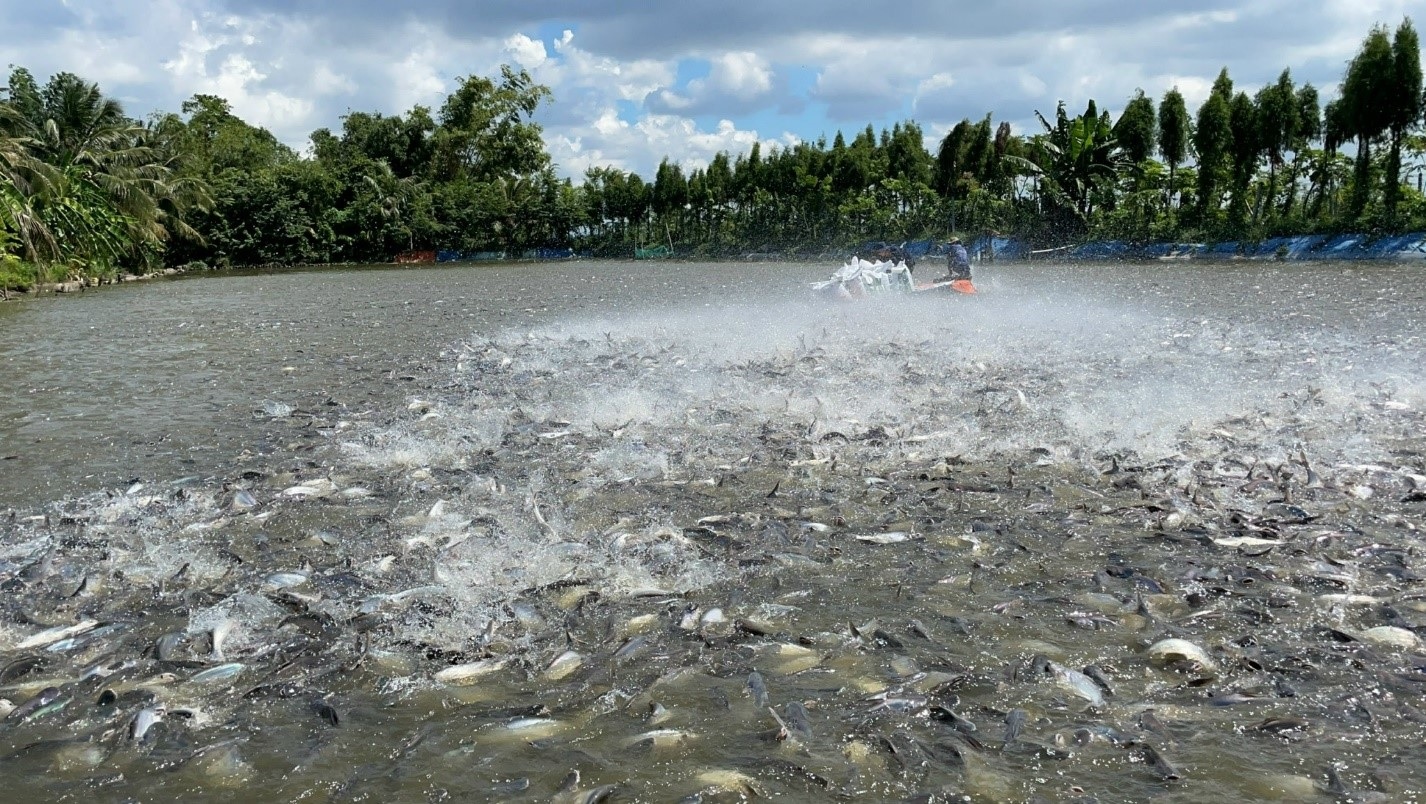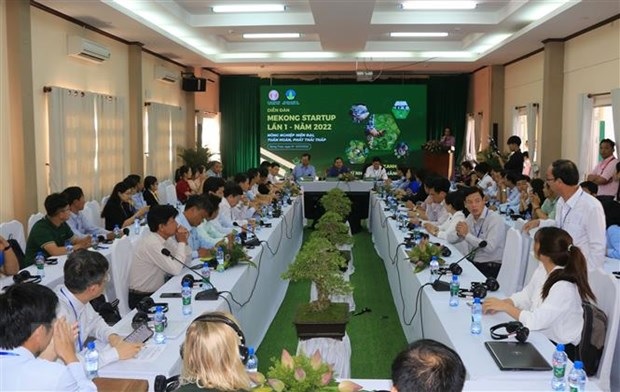(seafood.vasep.com.vn) The Mekong River Delta accounts for about 70% of Vietnam’s total hectares of aquaculture. This is the region with the largest production and value in the country, contributing about 65%.
In 2022, Vietnam's seafood industry grew strongly, reaching the highest export turnover ever with more than 10 billion USD. This result has contributed significantly to the fisheries industry in the Mekong Delta. Industries, localities and businesses in this region continue developing the fisheries sector to a modern, sustainable and low-emissions direction.
A successful year for the seafood industry
2022 can be considered a year of victory for the seafood industry in Dong Thap, especially the province’s pangasius industry. By the end of 2022, the total value of the province's seafood industry is expected to reach VND 12,831 billion, of which the pangasius industry will account for 64.1%.
Dong Thap is the largest pangasius producer in the Mekong Delta, accounting for over 33% of the area and 34.8% of pangasius production in the region. The province's pangasius export turnover accounts for about 40% compared to the whole country; annually supply about 60% of fish seed for the Mekong Delta.

An Giang province improve the quality of pangasius to meet the export standard (Cre: Vu Sinh/TTXVN)
Pangasius is the strongest growth export commodity
Mr. Huynh Minh Tuan, Vice Chairman of People's Committee of Dong Thap province said that by November 2022, the accumulated area of pangasius farming in the province was estimated at 2,450 hectares, up 17.3% over the same period in 2021.
The province’s production harvest volume reached 505,000 tons; exports were estimated at 270,077 tons, the exports turnover was estimated at 847 million USD, up 31% over the same period in 2021 and ranked first in the group of provincial exported agricultural products.
There are currently 28 enterprises operating in seafood processing (mainly processing frozen pangasius fillets for export) in Dong Thap, with a total capacity of more than 500,000 tons/year, attracting more than 25,000 workers.
Over the past time, Vietnam's seafood industry has become one of the key economic sectors, becoming the third largest export value in the country's economic sectors.
Currently, Vietnam has over 1 million hectares of aquaculture, about 70% in the Mekong River Delta. The aquaculture industry in the Mekong Delta is developing strongly, becoming the region with the largest output and value in the country, contributing about 65%.
The two key species in the region, which are pangasius - contributing about 98% and shrimp - contributing about 63% of the total production of the country. The strong development of aquaculture brings high economic efficiency and changes the economic structure of the Mekong Delta region, creating jobs and raising incomes and living standards.
According to Mr. Tran Dinh Luan, Director General of the Directorate of Fisheries, aquaculture is receiving great attention from the Party, State and Government.
On March 11, 2021, the Prime Minister signed Decision No. 339/QD-TTg approving the strategy of developing Vietnam's fisheries to 2030, with a vision to 2045.
The fisheries industry is directed to become a modern, sustainable commercial economy by 2045 with advanced management, science and technology. The fisheries will play an important role in the structure of agriculture and marine economic sectors .
The Decision also emphasizes the circular economy model, the green economy that would be further researched, applied and gradually replicated in the seafood value chain.
Mr. Tran Dinh Luan, Director General of the Directorate of Fisheries said that, like other agricultural sectors, aquaculture in the country in general and the Mekong Delta in particular are facing climate change, increasing emissions and environmental pollution.
The current trend of aquaculture in the world and Vietnam is green growth, sustainable development, efficiency and emission reduction. The orientation of developing the fisheries chain in the Mekong Delta towards modernity, sustainability and low emission is very necessary; contribute to the implementation of the strategy of developing Vietnam's fisheries to 2030, with a vision to 2045.
Regarding pangasius - one of the two main species in the Mekong Delta, Deputy Minister of Agriculture and Rural Development Phung Duc Tien assessed the potential and advantages of fisheries, especially aquaculture in the Mekong Delta is very large but has not been fully used. In the process of developing the pangasius industry, the region has to face many difficulties like the quality of seed and broodstock breed. He said that to develop the pangasius industry, it is necessary to overcome the above limitations and strengthen the application of science and technology to increase product value, meet the needs of the domestic market and export.
A number of enterprises in the Mekong Delta have invested in modern machinery and equipment and applied advanced science and technology to increase product value, reduce greenhouse gas emissions, and protect the environment.
Typically, Viet Uc seafood Corporation (An Giang province) applies technology to select and breed pangasius to improve export quality; My Lan Corporation (Tra Vinh province) has applied digital transformation technology in pangasius farming. Vinh Hoan Corporation (Dong Thap province) also applies science and technology in pangasius farming and processing to ensure export.

In the fish meat stage, the company tested the process of raising fish with limited water change (IPRS, environmental microbiology); prioritize the use of beneficial microorganisms, control harmful microorganisms, and limit the use of antibiotics.
The company uses by-products after processing pangasius to produce collagen, fish oil; apply modern technology for wastewater treatment, processing and fertilizer making from factory waste sludge.
Ms. Truong Thi Le Khanh, Chairman of the Board of Directors of Vinh Hoan Corp shared that improving the quality of pangasius through emission reduction is one of the potential directions to help raise the price of the product.
The competent authorities need to be trained in management knowledge to limit pangasius industry emissions to the environment; support research projects on emission reduction and circular economy.
"Green agriculture is a trend, a sustainable future, our business is committed to accompanying the State and Government towards the goal of reducing emissions and economic growth," Ms. Truong Thi Le Khanh affirmed.
To contribute to reducing emissions and modernizing the seafood industry, a number of companies have successfully researched and launched many useful technological products. Prominent is the digital platform for a sustainable aquatic ecosystem with the name Tomota of OTANICS Technology Joint Stock Company (Ca Mau province).

According to the Director of OTANICS Technology Joint Stock Company Vu Van Van, Tomota products are for shrimp farms such as managing shrimp farming equipment; water management in ponds; seed quality control; growth monitoring.
Moreover, Tomota can manage food with an electronic scale on the water, accurately recording to help manage effectively, feed according to the desired program, avoid food loss, waste and water pollution.
In addition, the room for marine aquaculture development is still very large, and it is necessary to promote this potential to create a new industry of seaweed production, contributing to reducing emissions.
Mr. Le Van Su requested relevant ministries and branches to support localities in implementing policies to encourage innovation in all fields of the agricultural sector.
Prioritize the application of digital, artificial intelligence (AI), Internet of Things (IoT) to management, operation and production organization for high-tech application of seafood production areas; digital transformation application for quality control, capture management and traceability of aquatic products.
Compiled by Thuy Linh